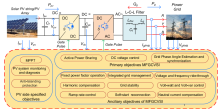A comprehensive review of grid-connected solar photovoltaic system: Architecture, control, and ancillary services
| Abstract | The installed capacity of solar photovoltaic (PV) based generating power plants has increased significantly in the last couple of decades compared to the various renewable energy sources (VRES). As a result, the increased penetration of solar PV-based generating units leads to several issues related to power quality, system stability, and reliability. In view of these concerns, various international standards and grid codes have been amended to address such critical issues. Therefore, most solar PV-based generating units have undergone several changes in operational and control structure. Subsequently, varieties of solar PV configurations and control structures have been proposed by several researchers to augment the desired operational features. This paper presents a comprehensive review of various solar PV configurations, control strategies, and ancillary services with multifunctional features within this context. The utilization and benefits of various configurations and their practical aspects have been discussed thoroughly for all the configurations and architectures. Apart from this, the control aspects of grid connected solar PV systems are categorized into two important segments, namely, a) DC-side control and b) AC side control. This article covers the important features, utilization, and significant challenges of this controller and summarizes the advanced control techniques available in the literature. Further, the various control techniques have been compared concerning different operational parameters, such as controller gains, duties, and selector quantities in tabular form with ready references. Furthermore, the concerns related to power quality, stability, and reliability of various techniques have been included for understanding the applicability of grid-connected PV systems. In the end, a detailed comparison of some available industrial inverters concerning their power ratings, voltage ratings, configurations, and advanced functions incorporated are also presented, which will help the researchers, academicians, and practicing engineers. |
| Faculty |
Ajay Kumar
|
|
ajaykumar@pec.edu.in
|
|
| Collaborations | MNIT Jaipur |
| More Information | DOI: doi.org/10.1016/j.ref.2023.04.009 |







